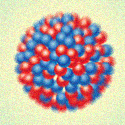Unequal parts
Traditional models of nuclear fission predict that heavy nuclei break into unequally sized (asymmetric) parts, which is consistent with the findings of most experiments in low-energy fission. This is naturally explained by the fact that one of the fragments tends to be in the vicinity of doubly magic tin- , which is highly stable.
The vast majority of fission experiments, however, have focused on heavy nuclides ranging from thorium to fermium. Now, new experiments performed at the ISOLDE facility in CERN and presented in Physical Review Letters (Andrei Andreyev et al.), probe a different corner of the nuclear chart. The team studies mercury- (with protons and neutrons) and finds that the fission products are also asymmetric. However, in this particular case, the outcome is counterintuitive, since a symmetric decay of the nucleus into two copies of zirconium- (with protons and neutrons) would have produced exceptionally stable nuclei.
The ISOLDE team’s puzzling result hints that a very subtle interplay between macroscopic and microscopic interactions plays a deeper role in the fission process than expected and is likely to inspire detailed theoretical studies and further experiment. – Abhishek Agarwal





